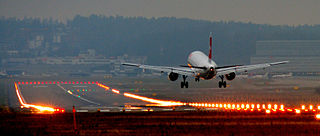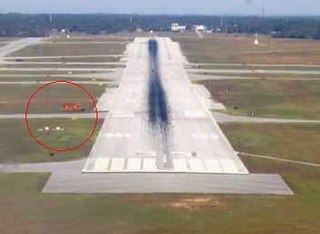 W
WAn approach lighting system, or ALS, is a lighting system installed on the approach end of an airport runway and consisting of a series of lightbars, strobe lights, or a combination of the two that extends outward from the runway end. ALS usually serves a runway that has an instrument approach procedure (IAP) associated with it and allows the pilot to visually identify the runway environment and align the aircraft with the runway upon arriving at a prescribed point on an approach.
 W
WAn optical landing system (OLS) is used to give glidepath information to pilots in the terminal phase of landing on an aircraft carrier.
 W
WA precision approach path indicator (PAPI) is a visual aid that provides guidance information to help a pilot acquire and maintain the correct approach to an airport or an aerodrome. It is generally located on the left-hand side of the runway approximately 300 meters beyond the landing threshold of the runway.
 W
WRunway edge lighting are used to outline the edges of runways during periods of darkness or restricted visibility conditions. These light systems are classified according to the intensity they are capable of producing:High intensity runway lights (HIRL) Medium intensity runway lights (MIRL) Low intensity runway lights (LIRL)
 W
WRunway end identifier lights (REIL) are installed at many airports to provide rapid and positive identification of the approach end of a particular runway. The system consists of a pair of synchronized flashing lights located laterally on each side of the runway threshold. REILs may be either omnidirectional or unidirectional facing the approach area. They are effective for:Identification of a runway surrounded by a preponderance of other lighting Identification of a runway which lacks contrast with surrounding terrain Identification of a runway during reduced visibility
 W
WAccording to the International Civil Aviation Organization (ICAO), a runway is a "defined rectangular area on a land aerodrome prepared for the landing and takeoff of aircraft". Runways may be a man-made surface or a natural surface. Runways, as well as taxiways and ramps, are sometimes referred to as "tarmac", though very few runways are built using tarmac. Runways made of water for seaplanes are generally referred to as waterways. Runway lengths are now commonly given in meters worldwide, except in North America where feet are commonly used.
 W
WA taxiway is a path for aircraft at an airport connecting runways with aprons, hangars, terminals and other facilities. They mostly have a hard surface such as asphalt or concrete, although smaller general aviation airports sometimes use gravel or grass.
 W
WThe visual approach slope indicator (VASI) is a system of lights on the side of an airport runway threshold that provides visual descent guidance information during approach. These lights may be visible from up to 8 kilometres (5.0 mi) during the day and up to 32 kilometres (20 mi) or more at night.